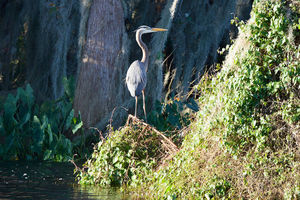It’s a chilly Friday morning, but the sun is beaming brightly, and so is Rick Goodman over the thought of capturing another glimpse of the newest tenant of his beloved Trout Lake, a 7- or 8-foot manatee that somehow found its way into the lake in recent months.
Goodman helps his guests board the tiny pontoon boat docked behind his Country Club Manor home, takes his seat at the rear and begins to inch the vessel through the narrow canal toward the lake.
It doesn’t matter that the manatee hasn’t been seen on this side of the lake and certainly not in Goodman’s canal. All eyes immediately begin to scan the black water ahead and the tree-lined banks to the sides for any sign of the gentle giant — the telltale brown disc of its back protruding from the surface, perhaps some bubbles indicating it is surfacing or even just a ripple.
The boat plows slowly, quietly through the water for the quarter-mile trip across the lake to the watery crevices where he might be hiding. Goodman and one of his passengers, Trout Lake Nature Center Executive Director Eileen Tramontana, begin to explain how the mammoth animal could have made its way into such a secluded, sheltered little body of water — through a small canal that connects Trout Lake to sprawling Lake Eustis under State Road 19.
Their attention is soon drawn to a majestic bald eagle soaring perhaps a couple of hundred feet above, gliding in circles atop the thermals that emanate from the lake. Then Goodman spots two enormous great blue herons sunning themselves on a clump of dirt and moss beneath a small stand of cypress trees just offshore. He shuts off the little electric motor — something he’ll repeat many times during the two-hour voyage to avoid startling skittish wildlife — admires them for a minute and then presses on in search of the manatee.
Spoiler alert: Goodman and his passengers never did spot the manatee on this morning, although it wasn’t for lack of effort. He navigated his little boat over large portions of the lake and beyond, into the canals that jut from its southern end like beads of water running downhill from a puddle.
“People say, ‘look for the bubbles because they blow air,'” Tramontana said. “They don’t actually blow air like a whale. They have flaps that cover their noses when they’re under water. They’re just gaseous.”
But what started out as a quest to find the gentle Trout Lake monster instead became a riveting nature lesson, with Tramontana and Goodman taking turns pointing out the birds, turtles and other critters that occupy seemingly every inch of the canals’ banks. Goodman, who “bought every book we could find on water birds,” offers colorful bits of trivia about each. The night heron has “very soft, kind-looking eyes,” and the anhinga is known as a snake bird because “when it’s in the water, you can just see its long neck sticking out.”
They spot a great egret, a big snow white bird with a bright yellow bill.
“They almost went extinct in the 1800s,” Goodman said, “because everyone was shooting them. The ladies liked their feathers for their hats.”
“That’s why they started the first sanctuaries,” Tramontana adds.
It isn’t just the number of species that astounds. It’s their size. These aren’t blue birds and robins fluttering unnoticed around residential neighborhoods. There are vultures, herons, cranes and eagles with 3- and 4-foot wingspans perched on mossy branches overhead or busily making and remaking nests. There was a large turtle standing sentinel on a muddy bank. And, of course, there are the ubiquitous Florida alligators, although the 42 degree temperatures kept them dormant and hidden on this day.
Tramontana offers a simple explanation for the bonanza of wildlife that thrives within sight and earshot of major highways and thickly clustered developments.
“Trout Lake, when you look at the shoreline, so much of it is undeveloped,” he said. “How many lakes are there like that in Florida?”
And in the middle of it all, day after day, are Tramontana and Goodman. Tramontana spends her days explaining the outdoors to Nature Center visitors, many of whom are small schoolchildren, in hopes of creating new generations of conservationists.
“If you’re interested in fishing, I hope to get you to understand how important it is to protect the resource so you can do that,” she said. “If you enjoy hunting, I want you to appreciate and want to protect the resource.”
And Goodman?
He developed his love for the water and outdoors growing up in Fort Lauderdale. He later moved to Pennsylvania and rekindled his love affair after retiring several years ago and spending his winters putting around the lake.
“When it’s nice weather — 55 or 65 degrees — I come out twice a day, in the morning and in the evening,” he said. “I love it.”
He even spends a day a year collecting trash that has become tangled in the weeds along the shoreline.
One of his favorite spots is the rookery, a massive stand of cypress trees on the north bank that is home to, literally, thousands of birds. He wishes his guests could see the show. In the evening, thousands of cormorants occupy every branch of every tree. An amazing sight, he said. And in the morning they all take flight suddenly in a massive exodus of black, fluttering wings.
“It’s just beautiful, quiet,” Goodman said of his beloved lake. “I do like the nature. I appreciate it. I like the God who made it. It’s part of me.”


